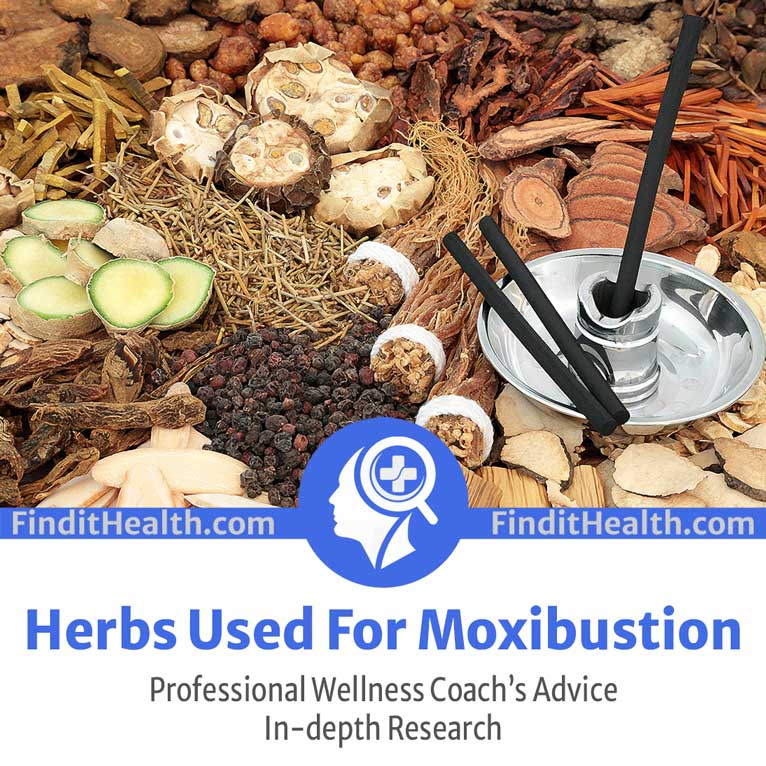
As the lead health and wellness coach at FindItHealth.com, I’m here to discuss what you need to know about burning herbs for moxibustion.
If you’d like to explore an alternative natural therapy, moxibustion has demonstrated efficacy in treating a variety of health problems, including pain alleviation, boosting fertility, and correcting breech postures. Learn how to apply moxibustion and increase its effectiveness for your particular application.

Moxa Herbs and Plants

- Mugwort
- Wormwood plant leaves
Origins
The terms “moxibustion” and “moxa” are both derived from the Japanese words “burning herb” (mogusa or mokusa).
Moxa comes in a variety of forms, from moxa charcoal sticks to moxa wool.
Moxa is always derived from the mugwort plant, scientifically known as Artemisia vulgaris or Artemisia argyii, regardless of the form it takes. For maximum potency, the leaves are matured for three to five years after harvesting and then crushed.
Use
Moxibustion is used to supplement acupuncture treatment. It is a type of cauterization used for healing and is frequently mentioned as a treatment for illnesses in old Chou period literature.
What’s Used?
The leaves and the flowering tops are the parts gathered and utilized in the moxa plant. This vigorous hardy woody perennial can be found throughout Europe but is less common in the northern regions. Mugwort is a commonplace weed that can grow in waste places and form thick and dense. In Canada, mugwort is an invasive weed that spreads rapidly as it propagates easily from minuscule rhizomes.
Pharmacological actions
The ingredients of moxa are wide-ranging and complicated. It consists of 60 kinds of components including volatile oils, tannins, flavonoids, and sterols, all of which contribute to the healing properties of moxa.
SUBSCRIBE for FREE STRESS MANAGEMENT TECHNIQUES from our EXPERT COACHES!
Moxa Herb Benefits

Moxibustion therapy is an alternative treatment that promotes the movement of energy via the body’s meridians. Chinese medicine technique holds that boosting your body’s flow of Qi or energy will aid in its attainment of health and wellness. Any obstructions to this energy flow result in diseases of the body and mind.
These obstructions that result in the following health conditions can be treated with moxibustion:
- Back pain
- Arthritis
- Headaches
- Migraines
- Muscle stiffness
- Tendonitis
- Ulcers
- Fatigue
- Infertility
- Menstrual cramps
- Abdominal pain
- Cancer
- Digestive problems
Moxibustion is especially effective and widely studied for breech presentation – wherein a baby is positioned with its feet first in the birth channel making normal delivery difficult.
Mugwort Moxibustion And Burning
Depending on the assessment of your moxibustion therapist, moxibustion may be applied onto the acupoint directly or indirectly. When applied directly, the lighted moxa rests on the site of treatment on your body. The practitioner then lights one end of the moxa leaving it to burn slowly. Once the skin turns reddish and you feel the heat the therapist removes the moxa.
In some cases, the acupuncturist lights the moxa on the needle – the moxa is left to burn until it goes out. The needle transmits the heat to the acupoint on the skin.
Another technique of application considered safer is indirect method wherein the burning moxa doesn’t come in direct contact with the skin. The practitioner holds the lighted moxa inches away from your body.
Another indirect application method is to apply a layer of salt or garlic as insulation. The therapist would apply salt or garlic to the skin before placing the lit moxa on top.
SUBSCRIBE for FREE STRESS MANAGEMENT TECHNIQUES from our EXPERT COACHES!
Burning Herbs: What Should You Use?

Herbs are often burned as incense to elicit its aromatherapy benefits. The correct approach to burning herbs is as follows:
Select a Bowl of the Right Size
For burning the dried herbs, a fireproof bowl made of metal or another material is advised. Steer clear of objects like glass or plastic that can catch fire and cause harm.
Choose your Favorite Dried Herb
For your particular objectives, such as relaxation, mental clarity, or headache relief, collect a variety of dried herbs.
Choose a Good Location
Put your incense bowl on an altar or in a secure location away from any potential fire hazards. Make sure nothing, such as a curtain drape, falls upon the bowl. It is best to use caution because you are working with fire.
Avoid placing the lighted incense bowl near any pet birds because they are highly sensitive to smoke. Other types of pets might be allergic to the smoke as well so avoid using it near places where pets eat, sleep or hang out.
Absorb the Energy and Fragrance of the Herb
Gather the unlit herbs first, then link to their energy. Light the entire herb when you’re ready, and let it burn for a few seconds. The embers will burn until they disappear.
Waft the Smoke
To keep the air moving and give the sticks of incense a chance to burn a little bit longer, use your hands to waft the smoke from the incense bowl upward. The ashes will fall into the bowl.
Remember that the type of herb, how dry it is, how much natural oil it contains, and how well you disperse the smoke around will all affect how long the herbs burn.
Allow the Lighted Incense to Go Out
Keep burning the incense until the flames and embers naturally extinguish. You can re-burn the herb to produce smoke if necessary. Wait until the entire plant material has been totally extinguished before discarding the herb or the ashes. To get rid of the smoke, you might need to spray the plant with water or let it sit for a while.
Consider the Herbs You’ll be Using Next Time
Aromas affect the olfactory system on a primal level. The human brain picks up recent memories and ancestral memories that could have an effect on body repair.
SUBSCRIBE for FREE STRESS MANAGEMENT TECHNIQUES from our EXPERT COACHES!
Effectiveness and Safety

Moxibustion is often a risk-free therapy when performed by a qualified professional. But moxibustion could result in adverse side effects if the acupuncturist does not remove the needles with care. Among the negative impacts are:
- Bleeding
- Dizziness
- Acute or chronic pain
- Blood buildup outside of a blood vessel, or hematoma
The following are other negative effects of moxibustion:
- Allergies
- Burns
- Infection
- Coughing
- Nausea and vomiting
It should also be noted that direct moxibustion which entails burning moxa on top of an acupoint on the skin can lead to blistering and scarring.
SUBSCRIBE for FREE STRESS MANAGEMENT TECHNIQUES from our EXPERT COACHES!
Frequently Asked Questions


What plant is used for moxibustion?
Often, dried mugwort or wormwood plant leaves are the main components of moxibustion items that are compressed into rolls, sticks, or other shapes.
What are the herbs found in moxibustion?
Dried mugwort is the main herb used in moxibustion. Depending on your unique condition and the preferences of your practitioner, additional herbs may be given along with the mugwort. Not just in China, but also in Japan, Korea, Vietnam, and Mongolia, moxibustion is a vital component of traditional medicine.
Moxibustion is often burned directly or indirectly onto the skin to enhance fertility. However, if you don’t like the burning of any type but still want to utilize herbs for fertility, we suggest the following:
- Chaste Tree – The chaste tree supports a woman’s menstrual cycle and good hormone levels in general, both of which improve fertility.
- Red Clover – Red clover contains isoflavones – plant-based chemicals that act like a weaker form of estrogen in your body.
- Saw Palmetto – Saw palmetto is supportive of prostate health that impacts fertility in men. As a traditional medicine in North America, it has a 150-year history as a male genitourinary tonic.
What herb do you burn for moxi?
As mentioned, moxa is made of rolled mugwort or wormwood leaves that are sometimes burnt as loose moxa leaf. For healing, moxa is burned close to acupoints and meridians on the body. Particularly sticky and able to take on various shapes is loose moxa. But the moxa cone shape is preferred by most practitioners.
The following equipment is required to apply moxa safely, effectively, and with the fewest possible accidents:
- Brass Moxa Burner – Moxa burners are used for indirect moxibustion. Often made from brass, this material allows for safe application of heat in the desired area. Moxa burners have chambers built in that let the user heat moxa from the inner chamber while adding ginger, garlic, and other herbs to the outer chamber.
- Moxa Extinguisher – Moxa extinguishers, made of stainless steel, are necessary for a moxa therapy clinic to snuff out the lighted moxa. To put out the flame, the lit end of the moxa roll adheres to the extinguisher.
- Moxa Extinguisher With Tray – Moxa extinguishers can be fitted with a 10.5 cm diameter stainless steel to increase stability and functionality. During the course of therapy, the tray might also be handy for gathering moxa ash.
What Herbs do Moxi Practitioners use?
The following herbs are used for moxibustion:
- Ai Ye (Artemisia argyi or mugwort leaf) – It is believed to have a stronger warming effect than Artemisia vulgaris and is often used for conditions such as cold and dampness in the body.
- Gou Ji (Cibotium barometz or golden hair fern) – It is commonly used in moxibustion to nourish the kidneys and alleviate lower back pain.
- Zi Su Ye (Perilla frutescens or beefsteak plant) – It has a warming and aromatic effect and is often used for respiratory conditions such as asthma and cough.
- Dang Gui (Angelica sinensis or female ginseng) – It is commonly used in moxibustion to tonify the blood circulation and regulate menstruation.
Xiang Fu (Cyperus rotundus or nutgrass) – It is often used in moxibustion to regulate Qi and alleviate menstrual disorders.
SUBSCRIBE for FREE STRESS MANAGEMENT TECHNIQUES from our EXPERT COACHES!
Conclusion – Research by Findithealth.com


Even though moxibustion is very effective on its own, mixing it with additional herbs may enhance its therapeutic effects. Various herbs are frequently mixed in traditional Chinese medicine to increase their potency or to treat particular medical conditions. For instance, including ginger in the moxa can enhance its warming properties.
However, it’s important to note that the use of additional herbs in moxibustion should only be done under the guidance of a qualified practitioner, as the combination of herbs used can vary depending on the individual’s health condition and needs.
Additionally, keep in mind that there are several grades of moxa, making it crucial to buy from a trustworthy merchant and confirm that the product you are receiving is, in fact, 100% moxa manufactured from mugwort leaves.
SUBSCRIBE for FREE STRESS MANAGEMENT TECHNIQUES from our EXPERT COACHES!


